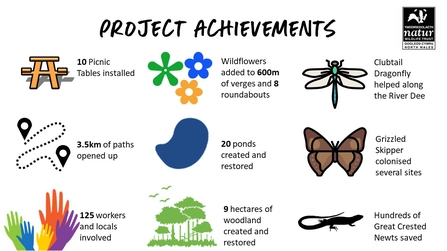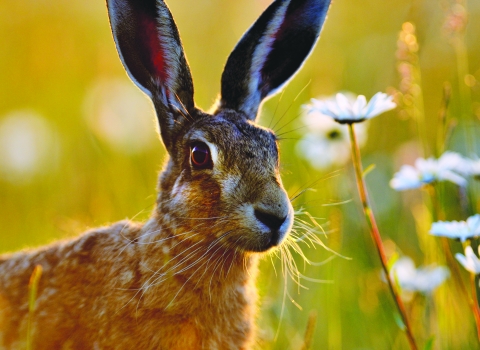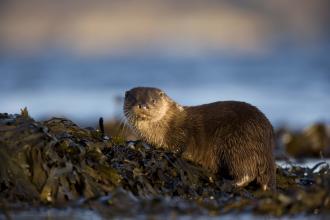Within one of Europe’s largest industrial estates lives an extraordinary range of wildlife that needs our help. Our work brings together people, wildlife and businesses in a novel way. We are improving habitats and making the area more attractive to work in. This not only helps people enjoy working there but attracts more businesses to the area. By doing this, we will be helping to save some of the most charismatic species to be found in Wales.

Our work on the industrial estate not only benefits wildlife, it also helps people to engage more with nature. Businesses are getting on board, workers are enjoying the improved surroundings, and people are visiting the estate to see its wildlife.
Below are photographs of some of our achievements.
Amazing wildlife
Brownfield sites are often home to a surprising array of wildlife. They can be second only to ancient woodland for their biodiversity. The open-ground habitats where warehouses once stood can support homes for a fascinating range of species. Below is a selection of some of the headline species that benefit from our work on the Estate.
Also...
- Badger (https://www.northwaleswildlifetrust.org.uk/wildlife-explorer/mammals/european-badger)
- Clubtail (https://www.northwaleswildlifetrust.org.uk/wildlife-explorer/invertebrates/dragonflies/common-clubtail)
- European eel (https://www.northwaleswildlifetrust.org.uk/wildlife-explorer/freshwater-fish/eel)
- Early purple orchid (https://www.northwaleswildlifetrust.org.uk/wildlife-explorer/wildflowers/early-purple-orchid)
- Green woodpecker (https://www.northwaleswildlifetrust.org.uk/wildlife-explorer/birds/woodpeckers-cuckoo-kingfisher-and-waxwing/green-woodpecker)
- Lapwing (https://www.northwaleswildlifetrust.org.uk/wildlife-explorer/birds/wading-birds/lapwing)
- Noctule bat (https://www.northwaleswildlifetrust.org.uk/wildlife-explorer/mammals/noctule)
- Red fox (https://www.northwaleswildlifetrust.org.uk/wildlife-explorer/mammals/red-fox)
- Skylark (https://www.northwaleswildlifetrust.org.uk/wildlife-explorer/birds/larks-sparrows-pipits-wagtails-and-dunnock/skylark)
- Swift (https://www.northwaleswildlifetrust.org.uk/wildlife-explorer/birds/swallows-swift-martins-and-nightjar/swift)
- Water vole (https://www.northwaleswildlifetrust.org.uk/wildlife-explorer/mammals/water-vole)
Explore walks on Wrexham Industrial Estate
Through our work on the industrial estate we have created areas that people can visit and explore: including Erlas Black Wood on behalf of Village Bakery; the Nature Space at Hoya Lens UK; and a section of Redwither Brook, by Ash Road South. In addition to this, we have worked with the local authority and businesses to open up footpaths so that workers, locals and visitors can explore, discover, exercise and enjoy the wildlife of the Estate. Below is a map showing places to visit and recommended short walks. Please click on the icons and lines for more information.
Badger icons = places to visit // Orange lines = recommended permissive paths and rights of way
Getting involved as a volunteer
We'd love you to join in with the project, whether you are a local, a visitor or working on the estate. In the process you can learn new skills, meet great people and get fresh air and exercise in a truly positive way. Some of the tasks that we undertake include installing bird and bat boxes, restoring ponds, signage, species surveys, hedge-laying and tree-planting and lots more! There is always work to do, so please get in touch if you’d like to help.


























